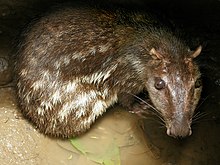This article needs additional citations for verification. (July 2014) |
| Paca[1] | |
|---|---|

| |
| Lowland paca | |
| Scientific classification | |
| Domain: | Eukaryota |
| Kingdom: | Animalia |
| Phylum: | Chordata |
| Class: | Mammalia |
| Order: | Rodentia |
| Infraorder: | Hystricognathi |
| Parvorder: | Caviomorpha |
| Superfamily: | Cavioidea |
| Family: | Cuniculidae Miller & Gidley, 1918[3] |
| Genus: | Cuniculus Brisson, 1762[2] |
| Type species | |
| Mus paca | |
| Species | |
|
Cuniculus paca | |
| Synonyms | |
|
For Cuniculidae:
For Cuniculus:
| |
A paca (from Tupí paka[4]) is a member of the genus Cuniculus of ground-dwelling, herbivorous rodents in South and Central America. It is the only genus in the family Cuniculidae.[5] Pacas are large rodents with dots and stripes on their sides, short ears, and barely visible tails. Pacas are eaten by people in Belize, where they are known as "gibnut" and, having been served to Queen Elizabeth II, "the royal rat".[6][7] In the Amazon basin they are known as "majás". In Guyanese English, it is known as labba from Arawak.[4]
- ^ Woods & Kilpatrick 2005
- ^ Brisson 1762
- ^ Miller & Gidley 1918
- ^ a b Simpson, George Gaylord (February 1941). "Vernacular Names of South American Mammals". Journal of Mammalogy. 22 (1): 6. doi:10.2307/1374677. JSTOR 1374677.
- ^ Cuniculidae in the Paleobiology Database. Retrieved March 2013.
- ^ Zimmern, Andrew (January 29, 2014). "Bizarre Bites: Rat". andrewzimmern.com.
- ^ Zimmern, Andrew. "Bizarre Foods: Feasting On A 'Royal Rat'". Travel Channel. Archived from the original on 11 April 2021.